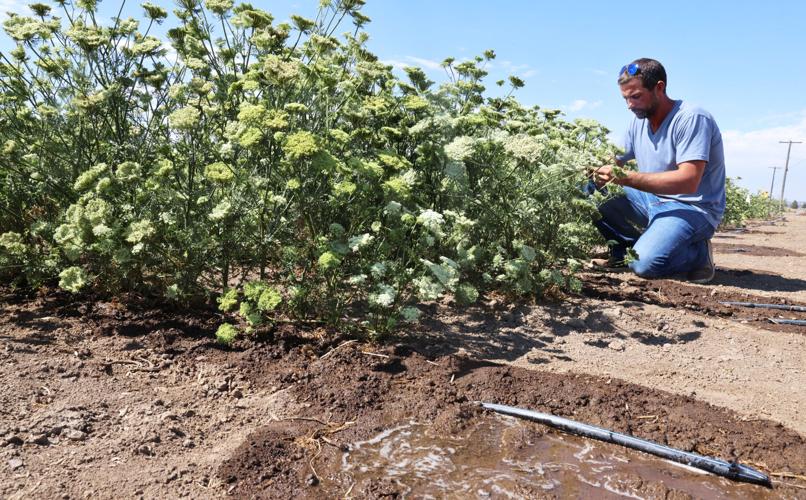This article was published on: 03/29/23 2:44 PM
Board approved 0.7 acre-feet of water to be delivered starting April 17, amount is nearly double last year’s allotment
By Michael Kohn
The North Unit Irrigation District, located in Jefferson County, will give farmers more water than they got in 2022. But the water allotment set Wednesday is conservative as drought conditions persist across Central Oregon.
Patrons of North Unit will receive 0.7 acre-feet of water per acre from the Deschutes River and 0.35 acre-feet from the Crooked River, the district’s general manager Josh Bailey said following a district board meeting Wednesday. Water delivery begins on April 17.
During the meeting, irrigation district operations staff presented current reservoir storage capacities, river flows and conserved water estimates to aid the district’s board of directors with making decisions on how much water could be delivered to farmers, said Bailey.
“The NUID board of directors considered current and projected weather conditions, snow conditions, stream and river runoff, reservoir storage, and projected conserved water while setting the 2023 allotment,” Bailey said. “While still considerably low, it’s better than last year’s historic low allotment.”
A year ago, district patrons were allotted just 0.45 acre-feet from the Deschutes River and 0.225 acre-feet of water from the Crooked River. Those were record-low allotments reflecting extremely low reservoir levels and low snowpack at the time.
This year’s allotment marks only the second time that North Unit patrons have received less than one acre-foot of water. As recently as 2018, the district had an allocation of 2.25 acre-feet of water.
“We always hope for more but we’ll take what we can get,” said Mike Kirsch, a Jefferson County farmer.
Kirsch said it’s a relief that the allotment is higher than a year ago but 0.7 acre-feet still won’t move the needle much on how much can be planted. He anticipates leaving 60% of his farmland fallow again.
“It’s not an easy time to be farming in North Unit Irrigation District or Jefferson County but if you look at the positives we get more than last year as far as the water allotment, and so far the weather coming out of the winter here is still cool with more moisture in the forecast,” said Kirsch.
Kirsch will try to navigate the small allotment by focusing on crops that offer good profit margins while operating in a low water environment, including grass seed, carrot seed and nursery stock.
“When you are operating on just 40% of your farm in production it makes it tougher to be in a profit margin you want to be at, you just have to focus on high-value crops and do what you can to reduce expenses and become as efficient as possible,” he said.
The slight increase is partially a reflection of the levels at Wickiup Reservoir, which stores water for North Unit. Last year at this time, Wickiup maxed out at 55% of capacity prior to the start of the irrigation season. This year it’s at 66%. Wickiup has not reached a level this high since April 2020.
In terms of snowpack, a year ago in the Upper Deschutes area, the snowpack was just 54% of normal while this year snowpack has more than doubled that amount and now stands at 134% of normal.
Starting in April, the reservoir level will begin to decline as more water pours out of the reservoir for the irrigation season.
Snowpack and reservoir levels are closely watched by farmers and ranchers in the High Desert, where crops mainly consist of hay, alfalfa, carrot seed and grass seed. The area is also home to cattle ranches and farms that grow organic vegetables.
While reservoirs in neighboring California are filling rapidly from this winter’s snow and rain storms, reservoirs in Central Oregon take longer to fill because of this region’s unique geology and topography.
Rather than running off into streams and rivers, precipitation sinks into the porous volcanic rock and enters underground aquifers before emerging months later from springs.
Larry O’Neill, an associate professor in the Oregon State University College of Earth, Ocean and Atmospheric Sciences, said snowpack this year has met expectations for a La Nina year.
The Climate Prediction Center outlook for April suggests that the cool weather may continue, although precipitation appears likely to be equal chances of above or below normal, O’Neill said.
“The cool weather will be most welcome, as it does not suggest it will melt out early this year, which is promising news,” he said.
While the cool weather and snowpack totals are encouraging, Central Oregon remains in various stages of drought. According to the U.S. Drought Monitor, 77% of Jefferson County is in severe drought or worse conditions.
“We are now late enough in the wet season to know with confidence that Central Oregon will likely be in some stage of severe to extreme drought throughout the upcoming summer,” said O’Neill. “The soils, in particular, are extremely dry, so when the snow does melt, much of that water will soak into the soil rather than run off into the streams and reservoir system.”
“Thus, the good snowpack may not be as beneficial for our summer water supply as it seems.”




